Impacts of Stressors on Riparian Health Indicators in the Upper and Lower Indus River Basins in Pakistan
Abstract
1. Introduction
2. Materials and Methods
2.1. Description of the Study Area
2.2. Field Investigation
2.3. Statistical Analysis
3. Results
3.1. Distribution of Riparian Zone Characteristics
3.2. Selection of the Principal Factors by Factor Analysis
3.3. Relationship between Stressors and Riparian Health Indicators
3.4. Comparing Indices and Sub-Indices from the Upper and Lower Indus Basins
4. Discussion
5. Conclusions
Supplementary Materials
Author Contributions
Funding
Institutional Review Board Statement
Informed Consent Statement
Data Availability Statement
Acknowledgments
Conflicts of Interest
References
- Stutter, M.; Baggaley, N.; Huallachain, D.O.; Wang, C. The utility of spatial data to delineate river riparian functions and management zones: A review. Sci. Total Environ. 2021, 757, 143982. [Google Scholar] [CrossRef] [PubMed]
- Arif, M.; Jie, Z.; Tahir, M.; Xin, H.; Changxiao, L. The impact of stress factors on riparian and drawdown zones degradation around dams and reservoirs. Land Degrad. Dev. 2022, 33, 2127–2141. [Google Scholar] [CrossRef]
- Belete, M.; Deng, J.; Abubakar, G.A.; Teshome, M.; Wang, K.; Woldetsadik, M.; Zhu, E.; Comber, A.; Gudo, A. Partitioning the impacts of land use/land cover change and climate variability on water supply over the source region of the Blue Nile Basin. Land Degrad. Dev. 2020, 31, 2168–2184. [Google Scholar] [CrossRef]
- Bylak, A.; Kukuła, K.; Ortyl, B.; Hałoń, E.; Demczyk, A.; Janora-Hołyszko, K.; Ziobro, J. Small stream catchments in a developing city context: The importance of land cover changes on the ecological status of streams and the possibilities for providing ecosystem services. Sci. Total Environ. 2022, 815, 151974. [Google Scholar] [CrossRef] [PubMed]
- de Mello, K.; Valente, R.A.; Randhir, T.O.; Alves dos Santos, A.C.; Vettorazzi, C.A. Effects of land use and land cover on water quality of low-order streams in Southeastern Brazil: Watershed versus riparian zone. Catena 2018, 167, 130–138. [Google Scholar] [CrossRef]
- Dai, X.; Zhou, Y.; Ma, W.; Zhou, L. Influence of spatial variation in land-use patterns and topography on water quality of the rivers inflowing to Fuxian Lake, a large deep lake in the plateau of southwestern China. Ecol. Eng. 2017, 99, 417–428. [Google Scholar] [CrossRef]
- Tape, K.D.; Christie, K.; Carroll, G.; O’Donnell, J.A. Novel wildlife in the Arctic: The influence of changing riparian ecosystems and shrub habitat expansion on snowshoe hares. Glob. Chang. Biol. 2016, 22, 208–219. [Google Scholar] [CrossRef]
- Yuancai, Q.; Arif, M.; Dong, Z.; Ting, W.; Qin, Y.; Bo, P.; Peng, W.; Wei, H. The effect of hydrological regimes on the concentrations of nonstructural carbohydrates and organic acids in the roots of Salix matsudana in the Three Gorges Reservoir, China. Ecol. Indic. 2022, 142, 109176. [Google Scholar] [CrossRef]
- Dempsey, J.A.; Plantinga, A.J.; Kline, J.D.; Lawler, J.J.; Martinuzzi, S.; Radeloff, V.C.; Bigelow, D.P. Effects of local land-use planning on development and disturbance in riparian areas. Land Use Policy 2017, 60, 16–25. [Google Scholar] [CrossRef]
- Guo, Z.; Boeing, W.J.; Borgomeo, E.; Xu, Y.; Weng, Y. Linking reservoir ecosystems research to the sustainable development goals. Sci. Total Environ. 2021, 781, 146769. [Google Scholar] [CrossRef] [PubMed]
- Tata, L.R.R. Biodiversity impact assessment of two large dam projects in India under long term multi-scenarios simulation. Impact Assess. Proj. Apprais. 2021, 39, 335–347. [Google Scholar] [CrossRef]
- Fu, L.; Ren, Y.; Lu, L.; Chen, H. Relationship between ecosystem services and rural residential well-being in the Xin’an river Basin, China. Ecol. Indic. 2022, 140, 108997. [Google Scholar] [CrossRef]
- Yu, S.; Xu, Z.; Wu, W.; Zuo, D. Effect of land use types on stream water quality under seasonal variation and topographic characteristics in the Wei River basin, China. Ecol. Indic. 2016, 60, 202–212. [Google Scholar] [CrossRef]
- Bombino, G.; Zema, D.A.; Denisi, P.; Lucas-Borja, M.E.; Labate, A.; Zimbone, S.M. Assessment of riparian vegetation characteristics in Mediterranean headwaters regulated by check dams using multivariate statistical techniques. Sci. Total Environ. 2019, 657, 597–607. [Google Scholar] [CrossRef] [PubMed]
- Arif, M.; Behzad, H.M.; Tahir, M.; Li, C. The impact of ecotourism on ecosystem functioning along main rivers and tributaries: Implications for management and policy changes. J. Environ. Manag. 2022, 320, 115849. [Google Scholar] [CrossRef]
- Galia, T.; Skarpich, V.; Hradecky, J.; Pribyla, Z. Effect of grade-control structures at various stages of their destruction on bed sediments and local channel parameters. Geomorphology 2016, 253, 305–317. [Google Scholar] [CrossRef]
- Rivaes, R.; Rodriguez-Gonzalez, P.M.; Albuquerque, A.; Pinheiro, A.N.; Egger, G.; Ferreira, M.T. Reducing river regulation effects on riparian vegetation using flushing flow regimes. Ecol. Eng. 2015, 81, 428–438. [Google Scholar] [CrossRef]
- Shieh, C.-L.; Guh, Y.-R.; Wang, S.-Q. The application of range of variability approach to the assessment of a check dam on riverine habitat alteration. Environ. Geol. 2007, 52, 427–435. [Google Scholar] [CrossRef]
- Muhammad, A.; Behzad, H.M.; Tahir, M.; Changxiao, L. Environmental literacy affects riparian clean production near major waterways and tributaries. Sci. Total Environ. 2022, 834, 155476. [Google Scholar] [CrossRef]
- Tao, Y.; Wang, Y.; Rhoads, B.; Wang, D.; Ni, L.; Wu, J. Quantifying the impacts of the Three Gorges Reservoir on water temperature in the middle reach of the Yangtze River. J. Hydrol. 2020, 582, 124476. [Google Scholar] [CrossRef]
- Francis, T.B.; Abbott, K.C.; Cuddington, K.; Gellner, G.; Hastings, A.; Lai, Y.-C.; Morozov, A.; Petrovskii, S.; Zeeman, M.L. Management implications of long transients in ecological systems. Nat. Ecol. Evol. 2021, 5, 285–294. [Google Scholar] [CrossRef] [PubMed]
- Muhammad, A.; Jiajia, L.; Tahir, M.; Jie, Z.; Changxiao, L. Environmental literacy scenarios lead to land degradation and changes in riparian zones: Implications for policy in China. Land Degrad. Dev. 2022, 4450, 1–17. [Google Scholar] [CrossRef]
- Johansen, K.; Phinn, S.; Dixon, I.; Douglas, M.; Lowry, J. Comparison of image and rapid field assessments of riparian zone condition in Australian tropical savannas. For. Ecol. Manag. 2007, 240, 42–60. [Google Scholar] [CrossRef]
- Arif, M.; Qi, Y.; Dong, Z.; Wei, H. Rapid retrieval of cadmium and lead content from urban greenbelt zones using hyperspectral characteristic bands. J. Clean. Prod. 2022, 374, 133922. [Google Scholar] [CrossRef]
- Charles, S.P.; Wang, Q.J.; Ahmad, M.D.; Hashmi, D.; Schepen, A.; Podger, G.; Robertson, D.E. Seasonal streamflow forecasting in the upper Indus Basin of Pakistan: An assessment of methods. Hydrol. Earth Syst. Sci. 2018, 22, 3533–3549. [Google Scholar] [CrossRef]
- Rafique, A.; Burian, S.; Hassan, D.; Bano, R. Analysis of Operational Changes of Tarbela Reservoir to Improve the Water Supply, Hydropower Generation, and Flood Control Objectives. Sustainability 2020, 12, 7822. [Google Scholar] [CrossRef]
- Habib ur, R.; Rehman, M.A.; Naeem, U.A.; Hashmi, H.N.; Shakir, A.S. Possible options to slow down the advancement rate of Tarbela delta. Environ. Monit. Assess. 2017, 190, 39. [Google Scholar] [CrossRef]
- Ahmed, M.F.; Rogers, J.D.; Ismail, E.H. Knickpoints along the upper Indus River, Pakistan: An exploratory survey of geomorphic processes. Swiss J. Geosci. 2018, 111, 191–204. [Google Scholar] [CrossRef]
- Naz, S.; Ahsanuddin, M.; Inayatullah, S.; Siddiqi, T.A.; Imtiaz, M. Copula-Based Bivariate Flood Risk Assessment on Tarbela Dam, Pakistan. Hydrology 2019, 6, 79. [Google Scholar] [CrossRef]
- Rashid, M.U.; Latif, A.; Azmat, M. Optimizing Irrigation Deficit of Multipurpose Cascade Reservoirs. Water Resour. Manag. 2018, 32, 1675–1687. [Google Scholar] [CrossRef]
- Rehman Qaisar, F.U.; Zhang, F.; Pant, R.R.; Wang, G.; Khan, S.; Zeng, C. Spatial variation, source identification, and quality assessment of surface water geochemical composition in the Indus River Basin, Pakistan. Environ. Sci. Pollut. Res. 2018, 25, 12749–12763. [Google Scholar] [CrossRef] [PubMed]
- Arif, M.; Jiajia, L.; Dongdong, D.; Xinrui, H.; Qianwen, G.; Fan, Y.; Songlin, Z.; Changxiao, L. Effect of topographical features on hydrologically connected riparian landscapes across different land-use patterns in colossal dams and reservoirs. Sci. Total Environ. 2022, 851, 158131. [Google Scholar] [CrossRef] [PubMed]
- Jansen, A.; Robertson, A.; Leigh, T.; Andrea, W. Rapid Appraisal of Riparian Condition, 2nd ed.; Land & Water Australia: Canberra, Australia, 2005; Volume 4A, pp. 1–16. [Google Scholar]
- Muhammad, A.; Behzad, H.M.; Tahir, M.; Changxiao, L. Nature-based tourism influences ecosystem functioning along waterways: Implications for conservation and management. Sci. Total Environ. 2022, 842, 156935. [Google Scholar] [CrossRef]
- Lanzanova, D.; Whitney, C.; Shepherd, K.; Luedeling, E. Improving development efficiency through decision analysis: Reservoir protection in Burkina Faso. Environ. Model. Softw. 2019, 115, 164–175. [Google Scholar] [CrossRef]
- Hu, X.; Arif, M.; Ding, D.; Li, J.; He, X.; Li, C. Invasive Plants and Species Richness Impact Litter Decomposition in Riparian Zones. Front. Plant Sci. 2022, 13, 955656. [Google Scholar] [CrossRef]
- Biswas, S.R.; Mallik, A.U.; Braithwaite, N.T.; Biswas, P.L. Effects of disturbance type and microhabitat on species and functional diversity relationship in stream-bank plant communities. For. Ecol. Manag. 2019, 432, 812–822. [Google Scholar] [CrossRef]
- Rodrigues, V.; Estrany, J.; Ranzini, M.; de Cicco, V.; Tarjuelo Martin-Benito, J.M.; Hedo, J.; Lucas-Borja, M.E. Effects of land use and seasonality on stream water quality in a small tropical catchment: The headwater of Corrego Agua Limpa, Sao Paulo (Brazil). Sci. Total Environ. 2018, 622, 1553–1561. [Google Scholar] [CrossRef]
- Wohl, E. The significance of small streams. Front. Earth Sci. 2017, 11, 447–456. [Google Scholar] [CrossRef]
- Ferreira, M.T.; Aguiar, F.C.; Nogueira, C. Changes in Riparian woods over space and time: Influence of environment and land use. For. Ecol. Manag. 2005, 212, 145–159. [Google Scholar] [CrossRef]
- Perry, L.G.; Andersen, D.C.; Reynolds, L.V.; Nelson, S.M.; Shafroth, P.B. Vulnerability of riparian ecosystems to elevated CO2 and climate change in arid and semiarid western North America. Glob. Chang. Biol. 2012, 18, 821–842. [Google Scholar] [CrossRef]
- Luke, S.H.; Slade, E.M.; Gray, C.L.; Annammala, K.V.; Drewer, J.; Williamson, J.; Agama, A.L.; Ationg, M.; Mitchell, S.L.; Vairappan, C.S.; et al. Riparian buffers in tropical agriculture: Scientific support, effectiveness and directions for policy. J. Appl. Ecol. 2019, 56, 85–92. [Google Scholar] [CrossRef]
- Arif, M.; Hussain, A.; Shahzad, M.K.; Khan, W.R.; Na, N.; Zarif, N.; Liu, X.; Amin, H.; Yukun, C. One Belt One Road Initiative: Pakistan’s forest-based sector investment opportunities within the context of globalization. Custos Agronegocio 2019, 15, 165–194. [Google Scholar]
- Zema, D.A.; Bombino, G.; Denisi, P.; Esteban Lucas-Borja, M.; Zimbone, S.M. Evaluating the effects of check dams on channel geometry, bed sediment size and riparian vegetation in Mediterranean mountain torrents. Sci. Total Environ. 2018, 642, 327–340. [Google Scholar] [CrossRef] [PubMed]
- Chen, Z.; Song, H.; Arif, M.; Li, C. Effects of hydrological regime on Taxodium ascendens plant decomposition and nutrient dynamics in the Three Gorges Reservoir riparian zone. Front. Environ. Sci. 2022, 10, 990485. [Google Scholar] [CrossRef]
- Behzad, H.M.; Jiang, Y.; Arif, M.; Wu, C.; He, Q.; Zhao, H.; Lv, T. Tunneling-induced groundwater depletion limits long-term growth dynamics of forest trees. Sci. Total Environ. 2022, 811, 152375. [Google Scholar] [CrossRef]
- Wang, R.; Xu, T.; Yu, L.; Zhu, J.; Li, X. Effects of land use types on surface water quality across an anthropogenic disturbance gradient in the upper reach of the Hun River, Northeast China. Environ. Monit. Assess. 2013, 185, 4141–4151. [Google Scholar] [CrossRef]
- Lidman, J.; Jonsson, M.; Burrows, R.M.; Bundschuh, M.; Sponseller, R.A. Composition of riparian litter input regulates organic matter decomposition: Implications for headwater stream functioning in a managed forest landscape. Ecol. Evol. 2017, 7, 1068–1077. [Google Scholar] [CrossRef]
- Hu, X.; Xie, T.; Arif, M.; Ding, D.; Li, J.; Yuan, Z.; Li, C. Response of Annual Herbaceous Plant Leaching and Decomposition to Periodic Submergence in Mega-Reservoirs: Changes in Litter Nutrients and Soil Properties for Restoration. Biology 2021, 10, 1141. [Google Scholar] [CrossRef]
- Ding, D.; Liu, M.; Arif, M.; Yuan, Z.; Li, J.; Hu, X.; Zheng, J.; Li, C. Responses of Ecological Stoichiometric Characteristics of Carbon, Nitrogen, and Phosphorus to Periodic Submergence in Mega-Reservoir: Growth of Taxodium distichum and Taxodium ascendens. Plants 2021, 10, 2040. [Google Scholar] [CrossRef]
- Xu, F.; Wang, Y.; Wang, X.; Wu, D.; Wang, Y. Establishment and Application of the Assessment System on Ecosystem Health for Restored Urban Rivers in North China. Int. J. Environ. Res. Public Health 2022, 19, 5619. [Google Scholar] [CrossRef]
- Yang, H.; Zheng, L.; Wang, Y.; Li, J.; Zhang, B.; Bi, Y. Quantifying the Relationship between Land Use Intensity and Ecosystem Services’ Value in the Hanjiang River Basin: A Case Study of the Hubei Section. Int. J. Environ. Res. Public Health 2022, 19, 10950. [Google Scholar] [CrossRef] [PubMed]
- Ding, Y.; Shan, B.; Zhao, Y. Assessment of River Habitat Quality in the Hai River Basin, Northern China. Int. J. Environ. Res. Public Health 2015, 12, 11699–11717. [Google Scholar] [CrossRef] [PubMed]
- Lencha, S.M.; Tränckner, J.; Dananto, M. Assessing the Water Quality of Lake Hawassa Ethiopia—Trophic State and Suitability for Anthropogenic Uses—Applying Common Water Quality Indices. Int. J. Environ. Res. Public Health 2021, 18, 8904. [Google Scholar] [CrossRef] [PubMed]
- Ding, D.; Arif, M.; Liu, M.; Li, J.; Hu, X.; Geng, Q.; Yin, F.; Li, C. Plant-soil interactions and C:N:P stoichiometric homeostasis of plant organs in riparian plantation. Front. Plant Sci. 2022, 13, 979023. [Google Scholar] [CrossRef]
- Qianwen, G.; Arif, M.; Zhongxun, Y.; Jie, Z.; Xinrui, H.; Dongdong, D.; Fan, Y.; Changxiao, L. Plant species composition and diversity along successional gradients in arid and semi-arid regions of China. For. Ecol. Manag. 2022, 524, 120542. [Google Scholar] [CrossRef]
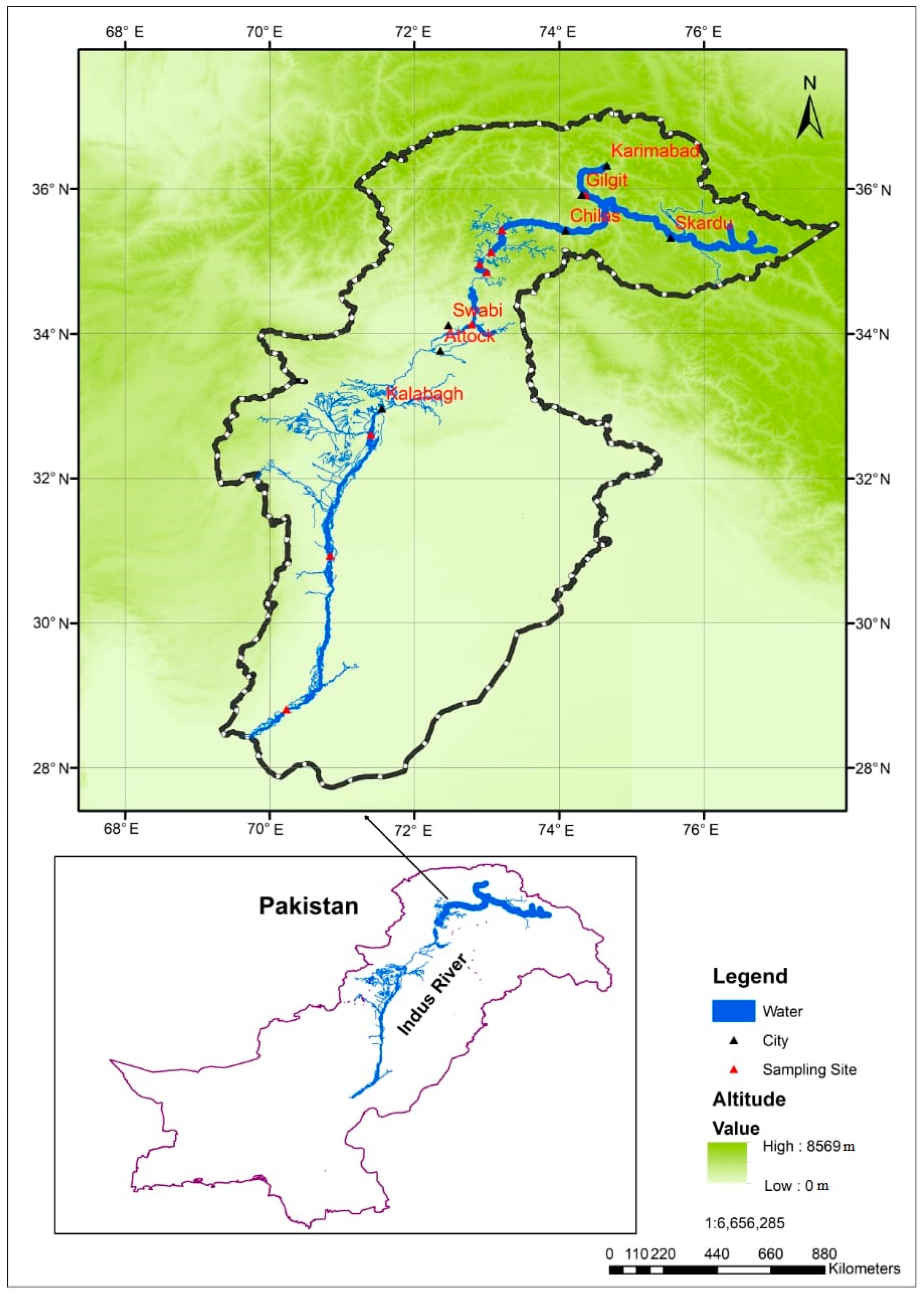
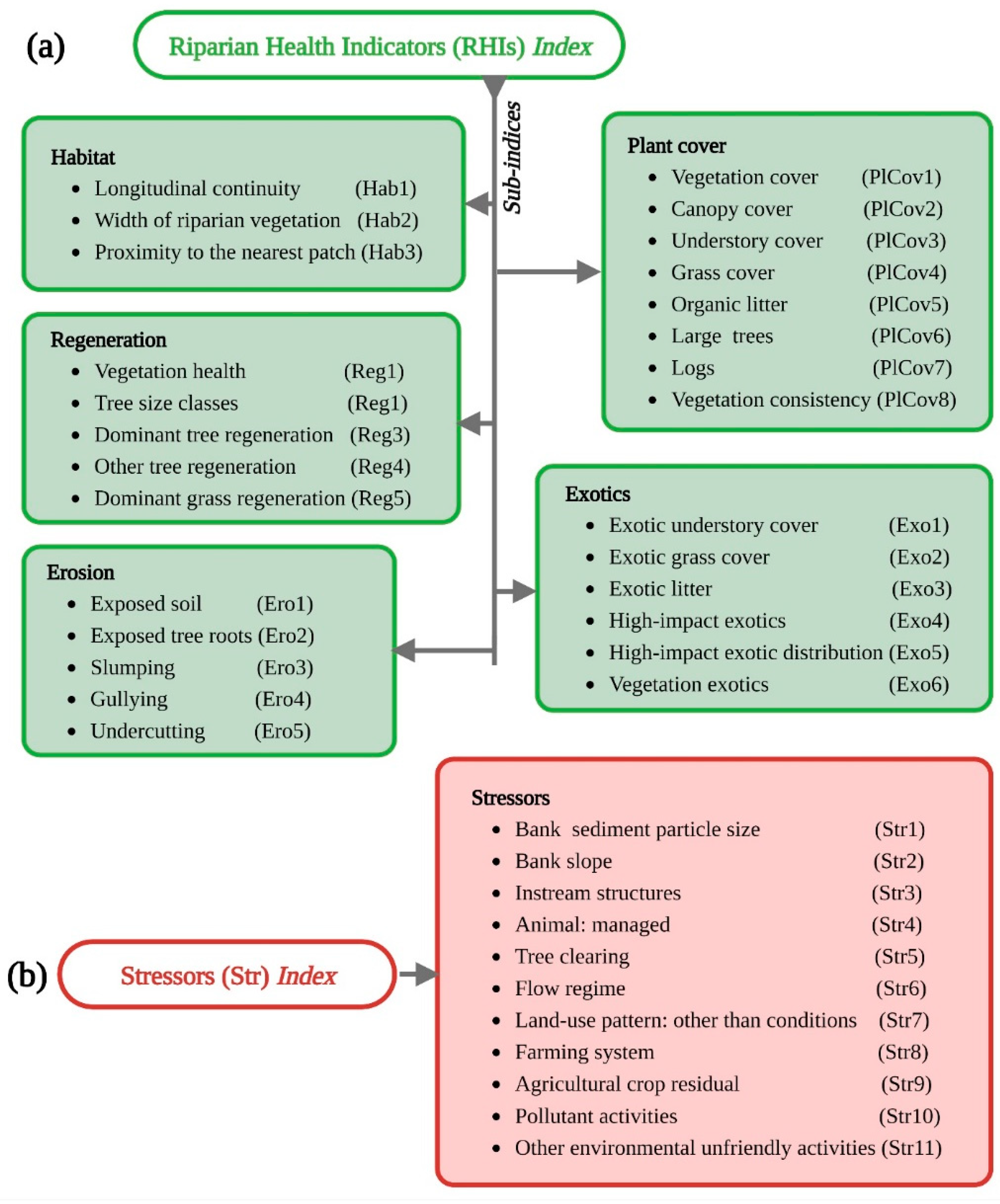
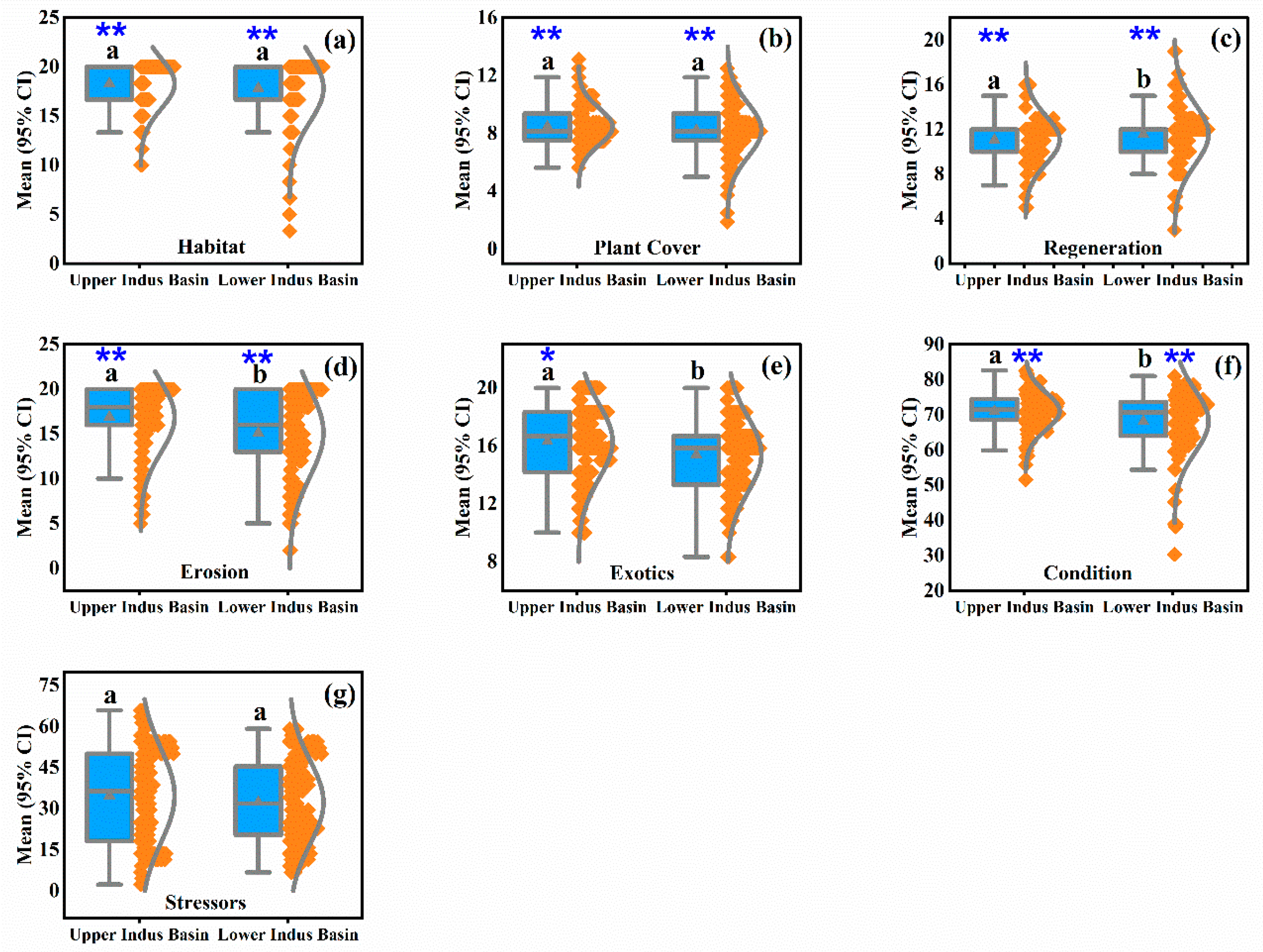
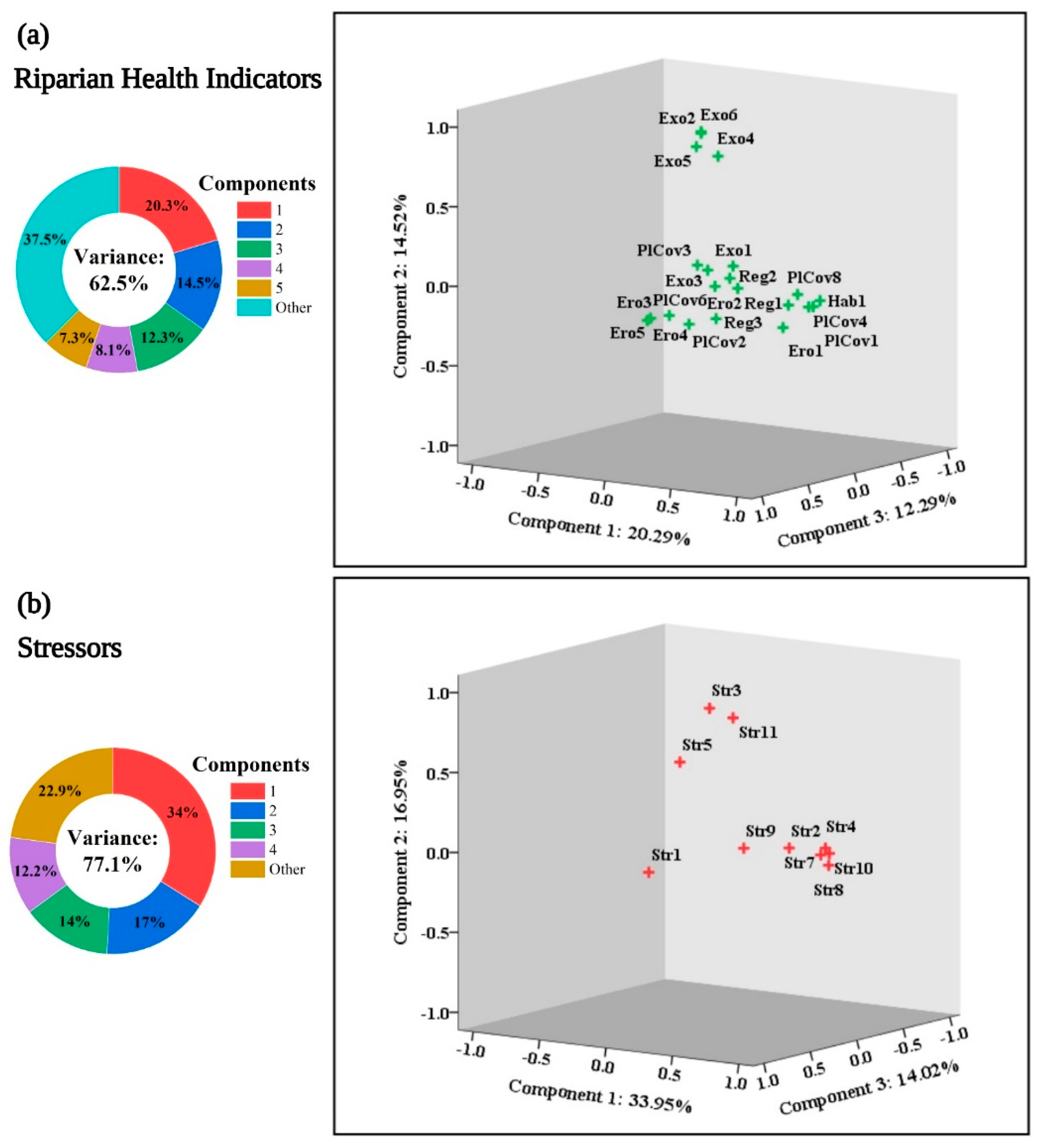
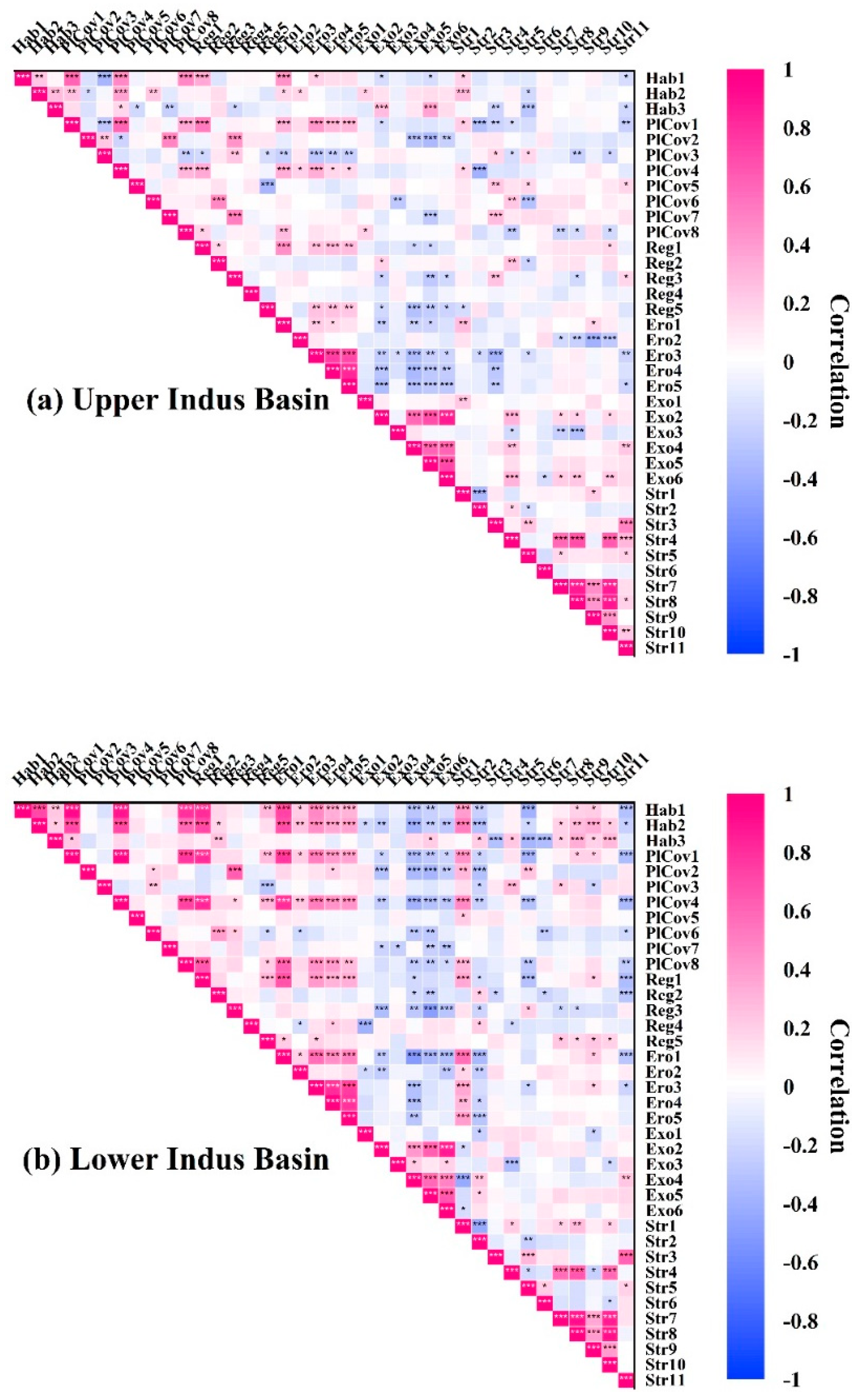
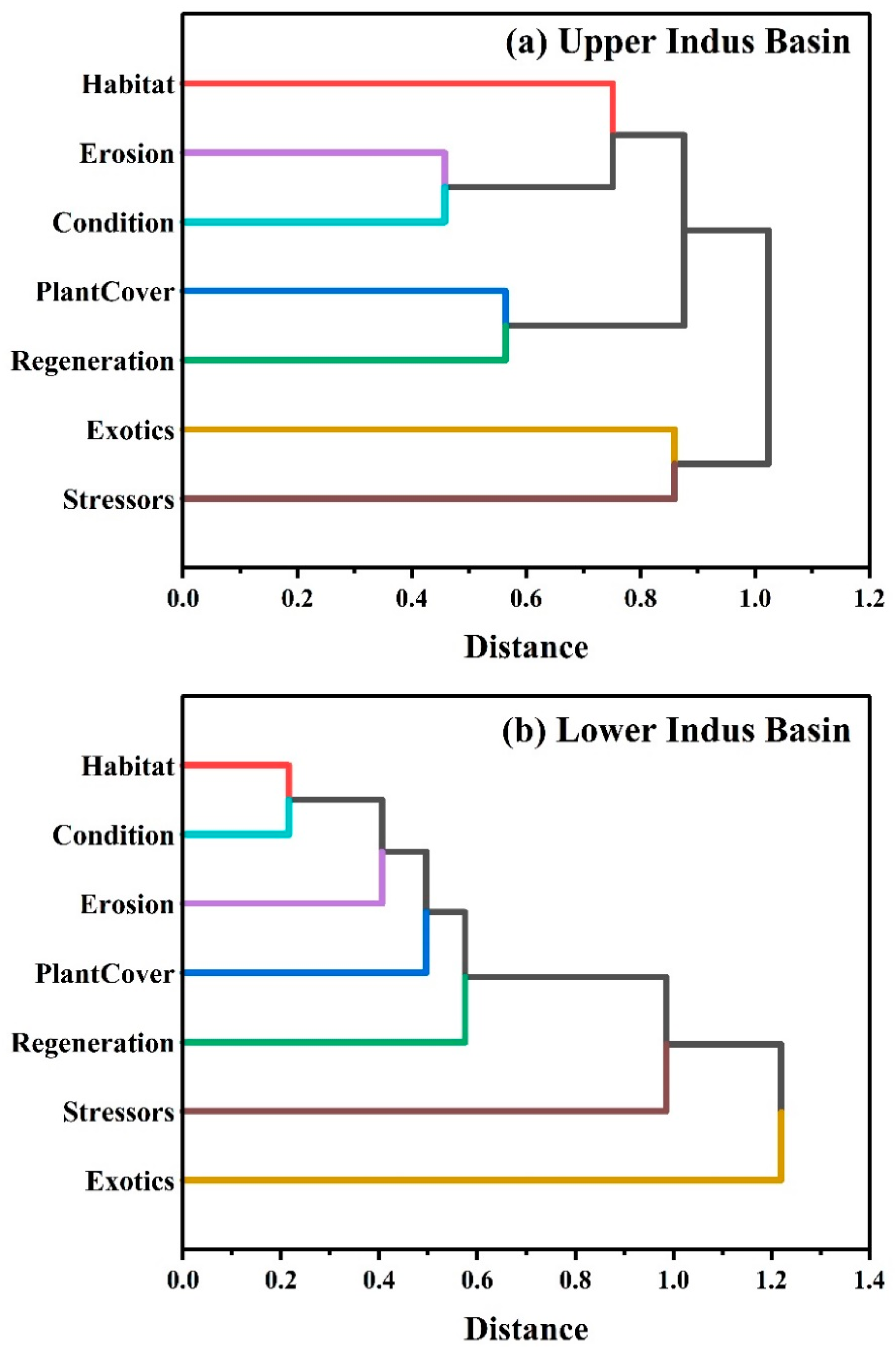
Publisher’s Note: MDPI stays neutral with regard to jurisdictional claims in published maps and institutional affiliations. |
© 2022 by the authors. Licensee MDPI, Basel, Switzerland. This article is an open access article distributed under the terms and conditions of the Creative Commons Attribution (CC BY) license (https://creativecommons.org/licenses/by/4.0/).
Share and Cite
Hira, A.; Arif, M.; Zarif, N.; Gul, Z.; Liu, X.; Cao, Y. Impacts of Stressors on Riparian Health Indicators in the Upper and Lower Indus River Basins in Pakistan. Int. J. Environ. Res. Public Health 2022, 19, 13239. https://doi.org/10.3390/ijerph192013239
Hira A, Arif M, Zarif N, Gul Z, Liu X, Cao Y. Impacts of Stressors on Riparian Health Indicators in the Upper and Lower Indus River Basins in Pakistan. International Journal of Environmental Research and Public Health. 2022; 19(20):13239. https://doi.org/10.3390/ijerph192013239
Chicago/Turabian StyleHira, Amin, Muhammad Arif, Nowsherwan Zarif, Zarmina Gul, Xiangyue Liu, and Yukun Cao. 2022. "Impacts of Stressors on Riparian Health Indicators in the Upper and Lower Indus River Basins in Pakistan" International Journal of Environmental Research and Public Health 19, no. 20: 13239. https://doi.org/10.3390/ijerph192013239
APA StyleHira, A., Arif, M., Zarif, N., Gul, Z., Liu, X., & Cao, Y. (2022). Impacts of Stressors on Riparian Health Indicators in the Upper and Lower Indus River Basins in Pakistan. International Journal of Environmental Research and Public Health, 19(20), 13239. https://doi.org/10.3390/ijerph192013239







